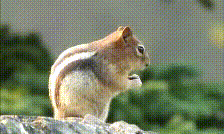WARM-UP EXERCISES
Parent Pages : Welcome To The Panorama and Pre-Emptive Listening.
If you're just starting then go and try out the short Central Exercises as well as you can. Then afterwards, come back here.

Preparation
Go outside: Animals developed this sense for using outdoors where things are moving and changing; long before humans invented safety indoors. Indoors there is no natural basis or incentive to go panoramic.Sit down for stability. You and your eyes aren't free to learn panoramic seeing when standing up and being still.
But this isn't a relaxation exercise. This is a time to be astutely aware as though it's a matter of life and death. The advantage humans have is that it's not a matter of life and death. We don't need to run and hide whenever we see a cat or dog.
Take off any glasses, they always create a division between the central and peripheral areas. This applies especially to sunglasses.
Let your eyes blink as normal but don't move the position of your head and eyes.
Remember, it's a human birthright. Short regular periods of stimulation act as a catalyst: A minute a day is the best way to tell your subconscious "it's time to remember".
Short periods reduce the concentrated work-load, make it easy, make it fun. To generate motivation we need to enjoy something, so if doing this – or even trying to do this – is enjoyable or interesting, then we will want to repeat it.
Try out these warm-up exercises.
Repeat whichever are enjoyable.
Check again and simplify with the Central Exercises.
Breaking Habits
We need to develop trust in our panoramic awareness. Otherwise, as soon as something moves or lights up we will automatically focus on it. As a general rule, to overcome this habitual response, fix your eyes on a boring, neutral, and motionless focal point straight ahead, a mark on a post or the corner of a building, anything which isn't interesting and doesn't move – fix your eyes on it, but be aware of, and on the lookout for everything else. Pay special attention to the peripheries.
As a general rule, to overcome this habitual response, fix your eyes on a boring, neutral, and motionless focal point straight ahead, a mark on a post or the corner of a building, anything which isn't interesting and doesn't move – fix your eyes on it, but be aware of, and on the lookout for everything else. Pay special attention to the peripheries.
Exercise 1 – the anti-fixed-stare
Every time you turn on your computer – instead of focusing directly on the screen, focus away from the screen and wait and watch for the screen to change peripherally.This is worth doing even for two seconds, waiting for individual programmes to load.
Re-educate your habitual urge to focus. Learn to trust your panoramic vision.
It is a very valuable exercise at all stages of life and learning.
(This one exercise only involves a limited part of the panorama, so if you wear glasses it's easier to leave them on.)
Exercise 2 – a stretching exercise
My first exercise in Welcome To The Panorama is easy and effective.
Look straight in front, but then direct your attention to two specific and opposite points on the extreme periphery at about 2 and 10 o'clock, etc. Can be done indoors, outdoors, day or night, in a doctor's waiting room, anywhere, anytime.
Exercise 3 – an all round stretch
Based on the previous exercise. Locate 4, 5, or 6 focal points around the periphery. Look straight ahead and recognise the peripheral points one after the other, build them up until you can be conscious of them all at the same time.
At night-time, lights, lamps and candles and their reflections in windows, are optimal peripheral focal points. I think it's best to have two or three sources of light, and then add two pinpoint objects which you have to mentally 'reach out' for. The Magic Terrace is an ideal example of this.
Exercise 4 – in the city
In the city, with lots of human activity, there is an almost instant way to start seeing panoramically.
Almost all human movement happens horizontally. Sit on a street corner, or in a pedestrian zone. Look upwards where nothing's moving, find the corner of a building, a chimney pot or corner of a signpost to focus on.
But then notice the people, push-bikes and cars which are passing by in the bottom half of your field of vision. Watch for new things moving into your field of vision and follow them till they pass out of range.
A good game is to pick two cars or people showing bright colours going in opposite directions and follow both. Evenings or nights, follow the red and white lights as they come into and pass out of sight.
Then hang your head and focus on a crack in the pavement, or your knees – and revitalise the upper half of your field of vision. Once you get the feeling for it, you can easily do these exercises for two to five minutes.
If you can find a pillar or something monotonous and boring in front of you, blocking the central area, focus on it and watch everything else.
If it's raining or mid-winter, the same ideas can be applied to sitting in cars.
A blank space is essential when learning, and will always be helpful. Once you can do it, you can look anywhere; but flashing lights, vivid moving colours, and beautiful girls / handsome men, will always be tempting focal points.
The Pure-School Method
Find a blank featureless wall, or a large monotonous area of sky, any area which has no focal point – look directly at it, but be aware of everything. Keep watch especially at the peripheries. See everything without looking directly at anything. Wait until it all becomes the oval shape of your field of vision, then look at the whole picture.
See everything without looking directly at anything. Wait until it all becomes the oval shape of your field of vision, then look at the whole picture.
It's obviously best in the countryside, with no walls anywhere, good weather and an empty sky to rest your eyes on.
In wooded areas it's difficult to find an unmoving, boring, monotonous area to fix the eyes on. Even facing a tree trunk can get interesting. But don't create difficulties, just pay attention to the peripheries. Then look at everything in your oval field of vision.
Combining Seeing and Listening
All these exercises may only bring you to the edge of the experience.What is missing from all of them is listening at the same time.
With seeing alone, unless you've three or four movements to watch simultaneously, you will probably still be slowly thinking.
Listening is the way to stop thinking. You can't think when you are listening-out.
Meditations frequently practice listening to something beautiful, silence, or panoramic listening. These are compared with the pre-emptive method and it is developed in depth, in The Various Forms of Listening Meditation.
 Remember, background sounds, even if they're as lovely as the river flowing, are largely irrelevant – just listen-out for anything new.
Remember, background sounds, even if they're as lovely as the river flowing, are largely irrelevant – just listen-out for anything new.
It's natural and easy to notice things when they start, or when they are quick and sudden. Animals do it everyday. Animals have to do it, the first signs are the warning signals. The quicker and more sudden the movements are, the more you'll notice them.
We experience vibrations through our entire body. This is probably not a beginners exercise and is developed in The Various Forms of Listening Meditation.
Pre-emptive listening stops us thinking for a moment. Maybe you'll think "what's the next sound going to be?" And then you just wait.
Ideal Situations
In Welcome To The Panorama, i described how we sometimes spontaneously have a panoramic experience, looking into the distance with a landscape or seascape.But when we think about it afterwards we focus on the memory of that landscape, instead of realising that the landscape opened our senses in a way which we can use everyday.
So go somewhere with a view. But leave your camera at home, don't focus on anything, and don't think about anything... start listening to stop thinking.
If you live somewhere where you can see a clear view of the stars at night, lie down on the grass and watch them all.
Another ideal situation, is to lie down in the centre of a clearing in the woods, look at a clear sky, and watch the leaves on the trees moving all around the peripheries.
Not ideal, but, if it's winter or raining... the same idea can be applied to lying down indoors, and looking at the blank and boring ceiling but being aware of all the interesting, colourful things on the walls.
The peripheries are of special importance. New objects often come in from behind or above and are seen first at the peripheries.
Don't look into the sun, but bright or flashing lights are helpful behind you, light and shadows from behind show on the periphery.
If possible, sit with your back to the wind. Sounds and smells are carried by the wind. You are 'senseless' behind you if you sit facing the wind.
Panoramic awareness is best to develop with a number of different methods, in lots of different situations.
Above all, use your common sense.
All these ideas are further explored in The Practical Panorama which includes Reasons for sitting down and Reasons for short one-minute sessions.
Please continue with The Central Exercises
Back to Chapter One : The Animal Teachings
Back to THE PANORAMA SENSES Priority Pages